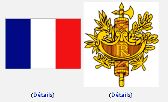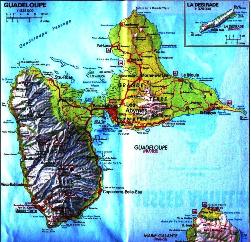|
Guadelupa
|
|
 |
 |
 |
|
|
Guadeloupe-
terytorium zamorskie Francji
Guadeloupe - porty.
Marie-Galante -porty.
Les
Saintes -porty
Saint Martin - wyspa podległa regionowi Gaudelupy.
Link do
ciekawego opisu
i galerii (ang.)
informacje zaczerpnięte z encyklopedii: PWN,
Brytanika
Galen R.
Frysinger:
galeria
pięknych zdjęć z dużą ilością opisów (ang.)
Bogata
informacja wraz z dużą ilością kontaktów, zdjęć i tekstów -
Antilles Info (ang.
franc. niem.)
CIA
World Factbook -
Guadeloupe
(ang.)
Guadeloupe - Antiles (franc.)
Portal
turystyczny
Lonley
Planet (ang.)
Portal
rządowy - prefektura (franc.)
Bardzo
ciekawy i bogaty portal:
Guadeloupe
Info (franc. niem. ang. włosk.)
|
|
|
PWN
GWADELUPA,
Guadeloupe,
departament zamor. Francji, w Ameryce Środk., w Indiach Zach., na wyspach
w Małych Antylach (archipelag W. Podwietrznych); pow. 1,8 tys. km2,
w tym wyspa Gwadelupa 1438 km2, Marie-Galante 158 km2,
Saint-Martin 52 km2 (część franc.), Saint-Barthélemy 21 km2
i Désirade 20 km2 oraz grupy wysp — Les Saintes, Îles de la Petite
Terre i Tintamarre; 431 tys. mieszk. (1996), Mulatów 77%, Murzynów 10%, Kreoli
10%; ludność katol.; stol. — Basse-Terre (na wyspie Gwadelupy); język urzędowy —
franc.; jednostka monetarna — frank francuski. Wyspy pochodzenia wulk.
i koralowego; wyspa Gwadelupa składa się z 2 części rozdzielonych kanałem
Rivière Salée: zach. (Basse-Terre) — górzystej, z czynnym wulkanem Soufrière
(wys. 1467), oraz wsch. (Grande-Terre) — nizinnej; klimat wysp równikowy
wilgotny; średnia roczna suma opadów 1800 mm; cyklony; lasy (39% pow.) równikowe
wilgotne, w dużym stopniu zdegradowane. Podstawą gospodarki jest obsługa
turystów (303 tys. osób — 1991); zmniejsza się znaczenie rolnictwa; produkt
krajowy brutto wynosi 6073 dol. USA na 1 mieszk. (1989); gospodarka jest
kontrolowana przez kapitał franc.; uprawa trzciny cukrowej, bananów, pomidorów,
ananasów, drzew cytrusowych, wanilii; hodowla bydła i trzody chlewnej;
rybołówstwo; produkcja cukru, rumu, odzieży oraz mebli; cementownie; hotele;
porty lotn.; gł. port mor. — Pointe-à-Pitre (na wyspie Gwadelupie); wywóz
bananów, rumu, cukru; handel z Francją, Martyniką.
Historia.
W 1493 odkryta przez K. Kolumba; 1635 opanowana i kolonizowana przez Francuzów;
w 2 poł. XVIII i pocz. XIX w. pod władzą Brytyjczyków, 1816 przyznana
ostatecznie Francji; od 1946 jej departament zamor.; w latach 60. i 70.
XX w. niepokoje społ. związane z pogarszającą się sytuacją gosp. i wzrost
emigracji do metropolii; w latach 80. znaczne nasilenie działalności organizacji
niepodległościowych
|
|
 |
Ecyclopedia
Britannica
officially Department of Guadeloupe, French
Département de la Guadeloupe,
overseas département of France, a group of islands in the Lesser Antilles
chain in the eastern Caribbean Sea. The nearest neighbours of the principal
islands are the British dependency of Montserrat to the northwest and the
republic of Dominica to the south. The island of Martinique, also a French
overseas département, lies about 74 miles to the south. The main
territory of Guadeloupe consists of the twin islands of
Basse-Terre
to the west and
Grande-Terre
to the east, the two being separated by a narrow channel, the
Salée River;
other islands in the group are
Marie-Galante
to the southeast,
La Désirade
to the east, and
Saintes
Islands (Terre d'en Haut and Terre d'en Bas) to the south. Two more island
dependencies—Saint-Barthélemy and Saint-Martin (the southern third of which is
administered by The Netherlands as Sint Maarten)—are situated about 150 miles to
the northwest, lying to the northwest of the outer arc of the Lesser Antilles.
The total area of Guadeloupe is 687 square miles (1,780 square kilometres).
Basse-Terre, on the island of the same name, is the seat of government. The
largest urban area, however, centres around Pointe-à-Pitre on Grande-Terre, the
chief port and economic hub of Guadeloupe.
|
Relief
and drainage
Basse-Terre, which has an area of 364 square miles, has a chain of mountains
running north to south and culminating in
Soufrière,
a volcano 4,813 feet (1,467 metres) high; it erupted in 1797, 1837, and 1976 and
is now a source of hot springs and sulfur springs. Other summits of note are the
4,442-foot Mount
Sans Toucher
and the 4,143-foot
Mount de la Grande Découverte.
The mountain chain forms a watershed from which rivers run down to the sea. The
principal river on the island is the Goyaves; other rivers are the Grande Plaine,
the Petite Plaine, the Moustique, the Lézarde, and the Rose. Basse-Terre has a
beautiful coastline, indented with bays and fringed with picturesque beaches.
Grande-Terre has an area of 220 square miles and is generally low-lying; it has
only a few bluffs higher than 490 feet. Saint-Martin and Saint-Barthélemy are
rugged and rise to an altitude of 1,391 feet and 921 feet, respectively.
History
Visited on Nov. 4, 1493, by Christopher Columbus, the two main islands, then
together known as Karukera (Island of Beautiful Waters), were peopled by Caribs,
who had displaced the original Arawak inhabitants. The territory was consecrated
to Our Lady of Guadalupe of Extremadura in Spain, from whom it takes its name.
French rule
Preliminary attempts by the Spanish to establish themselves were repulsed by the
Caribs in 1515, 1520, and 1523. In 1626 the Spanish, who had established
themselves on the coast, were driven away by Pierre Belain d'Esnambuc, a
Frenchman who established a trading company. In 1635 two Frenchmen, Léonard de
L'Olive and Jean Duplessis d'Ossonville, landed and established a colony. Until
1640 the colonists fought against the Carib Indians, but thereafter the colony
prospered. Four chartered companies were ruined in successive attempts to
colonize Guadeloupe, and in 1674 it passed to the French crown, becoming a
dependency of Martinique, which it remained until 1775. Guadeloupe benefited
from the influence of Jean-Baptiste Labat (1663 to 1738), a strong personality
who was the effective founder of the Basse-Terre colony and who in 1703 armed
the African slaves (who had already been brought to the island) in order that
they might fight against the English; he also established the first sugar
refineries, thereby laying the foundations for the era of prosperity that
followed.
In 1759 Guadeloupe was occupied by the British for four years but was restored
to France in 1763. In 1794 it was again occupied by British troops, allied with
French royalists, but was recaptured by Victor Hugues, an official of the French
revolutionary government, who proclaimed the abolition of slavery and had
several hundred white planters massacred. When slavery was reestablished by
Napoleon's government in 1802, a revolt of the slaves occurred and culminated in
the heroic act of the antislavery forces, who blew themselves up at Matouba when
threatened by French forces under the command of General Antoine Richepanse;
Richepanse himself had been sent by Napoleon to pacify Guadeloupe, but he died
of yellow fever in the same year. The British occupied Guadeloupe in 1810;
however, after some changes in status, it was restored to France in 1816.
The abolition of slavery in 1848 was the most significant development of the
territory's 19th-century history. Universal suffrage was abolished during the
reign of Napoleon III of France, but in 1870 colonial representation in the
French Parliament was restored. In 1940 Guadeloupe gave its allegiance to the
Vichy government of Nazi-occupied France, but in 1943 it adhered to General
Charles de Gaulle's Free French forces. In 1946 it was given the status of a
French département, and in 1974 it became a région of France. |
|

